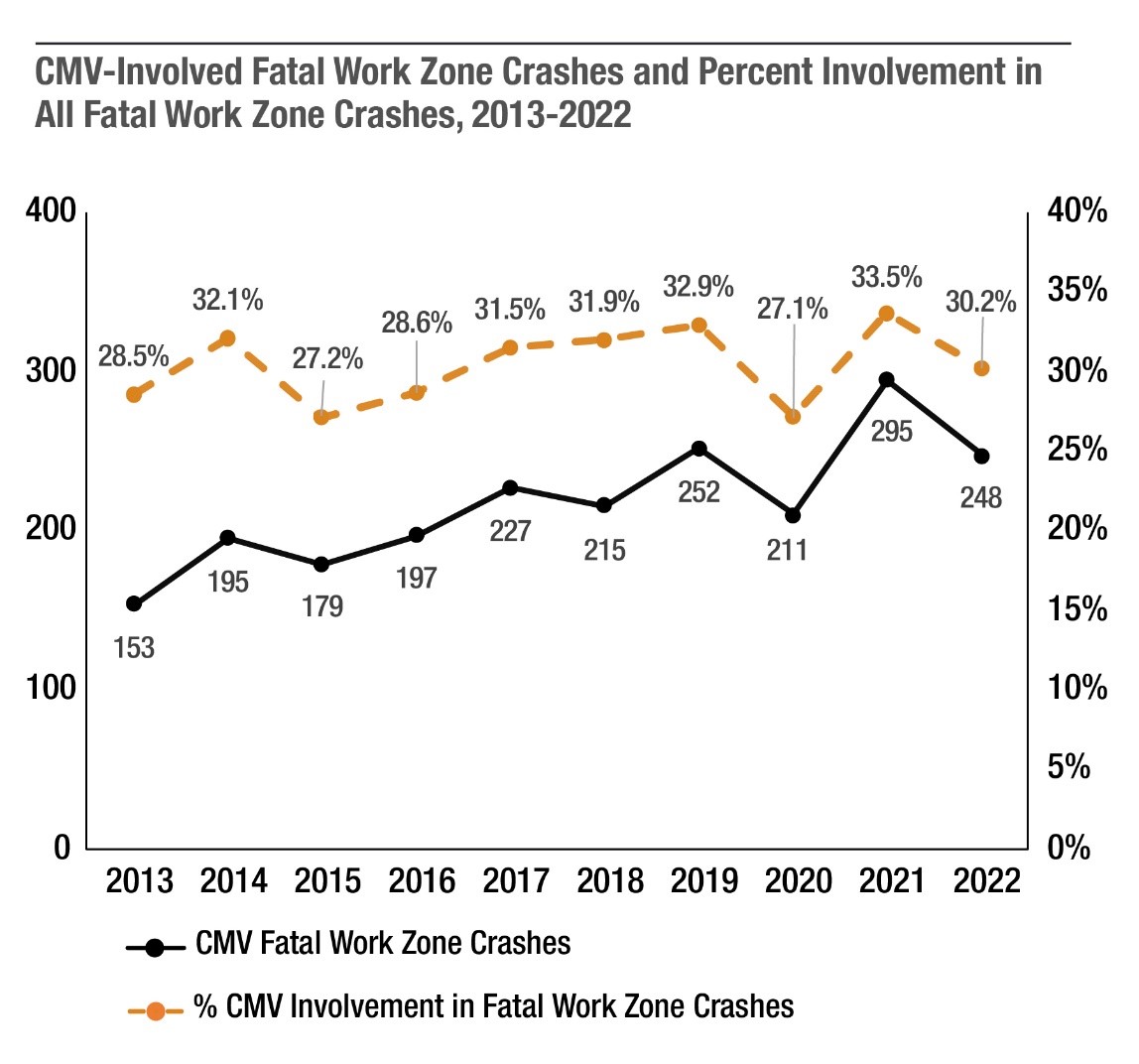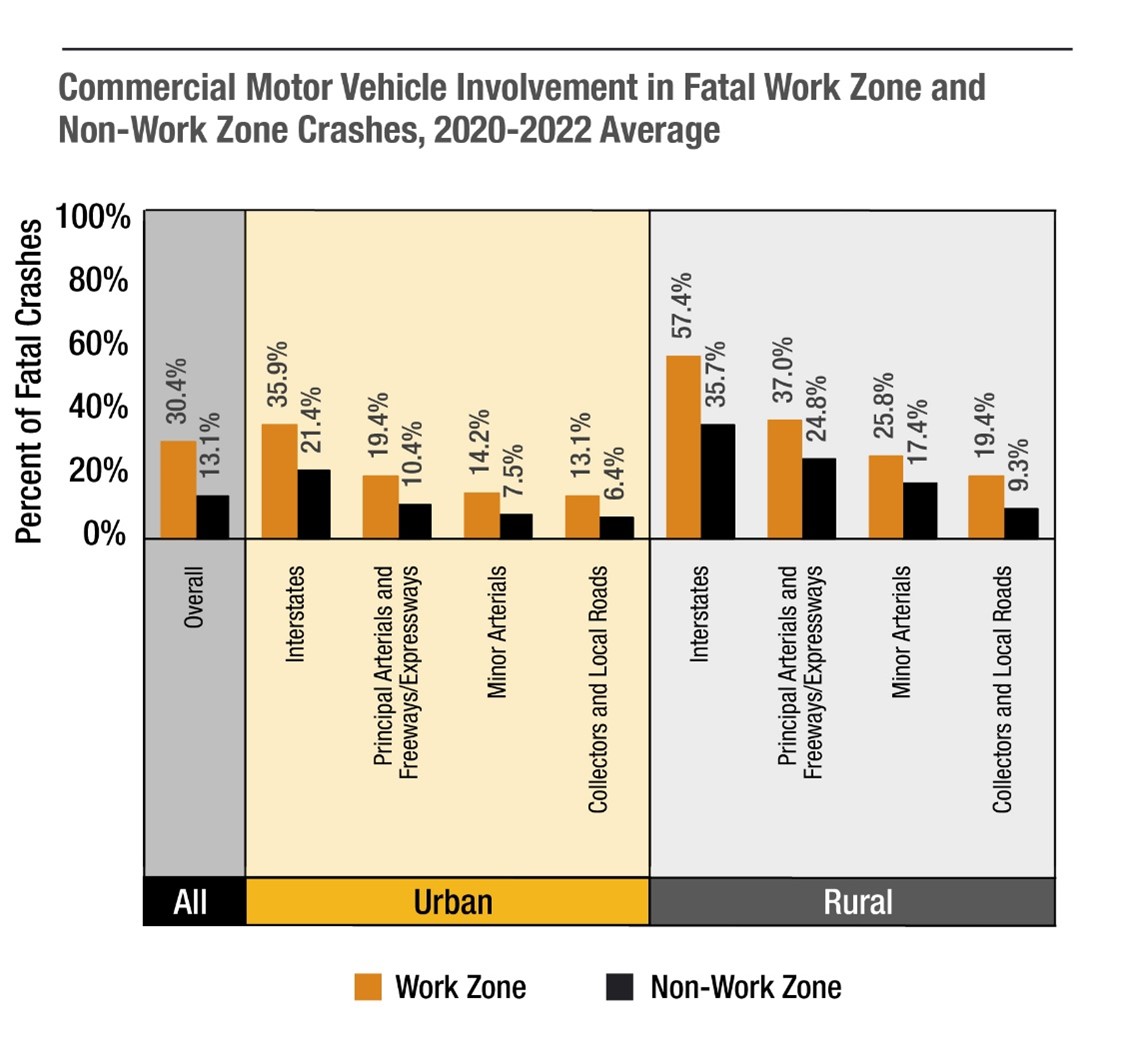Commercial Motor Vehicle (CMV) Safety in Work Zones
Overview
The Federal Highway Administration (FHWA), Federal Motor Carrier Safety Administration, and the National Highway Traffic Safety Administration (NHTSA) use the term CMV when referring to large trucks and buses with a gross vehicle weight or gross combination weight of 10,001 lbs or more. The NHTSA Fatality Analysis Reporting System (FARS) provides data on yearly fatal injuries in motor vehicle traffic crashes in the United States. In addition to a general data query system, FARS has specific information on trucks and buses involved in fatal crashes. FARS data indicate that in 2022, 248 of the 821 fatal crashes in work zones (30.2 percent) involved a CMV (figure 1). The overall trend in recent years has been an increase in CMV-involved fatal work zone crashes and in their involvement as a percentage of all fatal work zone crashes.

Source: Fatality Analysis Reporting System, NHTSA.
Figure 1. Commercial motor vehicle-involved fatal work zone crashes over the past 10 yr.
CMVs were overrepresented in CMV-involved fatal work zone crashes compared with CMV-involved fatal crashes outside of work zones. From 2020 to 2022, over 30 percent of all fatal work zone crashes involved a CMV, compared with about 13 percent of fatal crashes outside of work zones involving a CMV (figure 2). Over 57 percent of fatal work zone crashes on rural interstates involved a CMV, as did more than 36 percent of fatal work zone crashes on urban interstates.
The correlation between fatal work zone crashes and CMVs is known, and various State departments of transportation (DOTs) are taking steps to address this relationship. Through various workshops the FHWA Work Zone Management Program conducted, State DOTs shared their noteworthy practices to increase CMV safety in work zones. The following are several common noteworthy practices shared within the State DOT workshops.

Source: 2020–2022 Fatality Analysis Reporting System, NHTSA.
Figure 2. Percentage of CMV crashes involved in fatal work zone and non-work zone crashes by land use and facility type.
Noteworthy Practices
Early consideration of CMV impacts— During project scoping and preliminary design, engineers and designers should identify potential CMV issues and suggest mitigation strategies to better accommodate CMVs. This process could include considering the temporal effects of CMVs and conducting sensitivity analyses when considering queue formation potential and selecting queue mitigation measures. This practice can also involve checking for design components that might impact CMV safety, such as lane width, shoulder width and condition, buffer space, and transition and crossover design.
Dynamic lane merge—Dynamic lane merging involves the use of changeable message signs and advanced warning signs to provide directions to drivers about when to merge based on traffic conditions. Drivers are encouraged to merge early when traffic is free flowing. When traffic slows down, drivers should use all lanes to the merge point and then take turns moving into the open lane. By establishing merging behavior based on traffic conditions, roadway users will encounter shorter queue lengths, fewer last-second-merge-related issues, and reduced road rage. Key challenges encountered when implementing dynamic lane merging involve coordination with enforcement regarding move over law requirements and driver education.
CMV left lane use—Encouraging CMVs to use the left lane is beneficial when the right lane or shoulder pavement is not meeting adequate standards and to improve merging opportunities for vehicles entering roadways via on-ramps. Various tools—such as static signs, dynamic message signs, and pavement markings—can be used to communicate this lane preference.
Improve access point designs—The movement of large CMVs into or out of a construction access point can impact safety in work zones. To avoid accidents, separate acceleration lanes, deceleration lanes, or both could be provided for construction work vehicles to gradually enter or exit at construction access points. Smart work zone technology, such as static signs with beacons and dynamic message signs, can also be added to warn roadway users of vehicles entering and exiting in work zones. Speed enforcement and education are also crucial to communicate with roadway users.
Enforcement—The addition of law enforcement can aid in improving work zone safety. Positioning enforcement on the shoulder or using automated speed enforcement can deter dangerous roadway behaviors in work zones.
Education—Including CMV safety-related information in existing work zone safety materials, developing materials explaining how roadway users should properly execute a dynamic merge, and educating drivers about safety in work zones—especially around CMVs—can reduce the likelihood of accidents in work zones.
Outreach—Trucking industry representatives and associations can be invited to participate in the project development process to help identify potential CMV issues and mitigation strategies to better accommodate CMVs earlier in the process. Transportation agencies can also inform trucking industry stakeholders about upcoming and ongoing work zones, including information about lane closures, detours, and size/weight restrictions.
Additional information can be found in the following resources.
Resources
Publications
- Improving Commercial Motor Vehicles' Ability to Navigate Work Zone Lane Shifts—A FHWA Fact Sheet about INDOT's method to improve the ability of CMV drivers and other motorists to navigate through work zone lane shifts easily
- Providing In-Cab, Traffic-Related Warning Messages To Commercial Motor Vehicles—A FHWA Fact Sheet about NCDOT providing in-cab, real-time traffic congestion warning messages to CMV drivers.
- Design and Operation of Work Zone Strategies to Improve Large Truck Safety—An American Road & Transportation Builders Association (ARTBA) Work Zone Safety Consortium report that summarizes methods to design and operate work zones in a manner to reduce accidents involving CMVs.
- Separating Large Trucks from Non-truck Traffic in Work Zones—An ARTBA Work Zone Safety Consortium fact sheet that proposes the separation of large trucks and automobiles within work zones to reduce delays.
- Designing Work Space Access Points to Better Accommodate Large Trucks—An ARTBA Work Zone Safety Consortium fact sheet that proposes longer deceleration and acceleration lanes entering and exiting work zones.
- Guidelines on Work Zone Access and Egress—An ARTBA Roadway Safety Consortium guide that offers recommended practices and strategies to employ in work zones.
- Use of Smart Work Zone Technology to Improve Work Space Access Point Safety—An ARTBA Work Zone Safety Consortium fact sheet that identifies a potential solution to the presence of large trucks involved in work zone crash fatalities.
- Innovative End-of-Queue Warning System Reduces Crashes Up to 45%—An ARTBA Work Zone Safety Consortium case study that explains the effects of integrating an end‑of‑queue warning system in Texas.
- Safe Trucking Through Work Zones Brochure—An ARTBA Work Zone Safety Consortium brochure that offers safety tips for trucking through work zones.
- Safe Trucking Through Work Zones Presentation—An ARTBA Work Zone Safety Consortium presentation on how to travel safely through work zones.
- Work Zone Designer Series: Oversize/Overweight Vehicle Accommodation in Work Zones—A Wisconsin Traffic Operations and Safety Laboratory report on how to better accommodate oversize/overweight vehicles in construction zones.
- Technologies to Reduce Commercial Motor Vehicle Crashes in Work Zones—A Federal Motor Carrier Safety Administration summary report of key points raised during a multiagency meeting held in Knoxville, TN, in November 2014.
Training Opportunities
- Improving Large Truck Safety in Work Zones online course—ARTBA Work Zone Safety Consortium
- Separating Large Trucks from Non-Truck Traffic in Work Zones online course—ARTBA Work Zone Safety Consortium
- Designing Work Space Access Points to Better Accommodate Large Trucks online course—ARTBA Work Zone Safety Consortium
- Using Smart Work Zone Technology to Improve Work Space Access Point Safety online course—ARTBA Work Zone Safety Consortium
Other Resources
- 2021 CMV Safety in Work Zones Webinar Recording
- Federal Motor Carrier Safety Administration work zone safety tips
- Illinois DOT Work Zone Awareness fact sheet incorporating CMV data and guidance
For more information: contact Martha Kapitanov at Martha.Kapitanov@dot.gov.
To Join the National Work Zone Safety Information Clearinghouse LISTSERV™: https://www.workzonesafety.org/listserv/.
